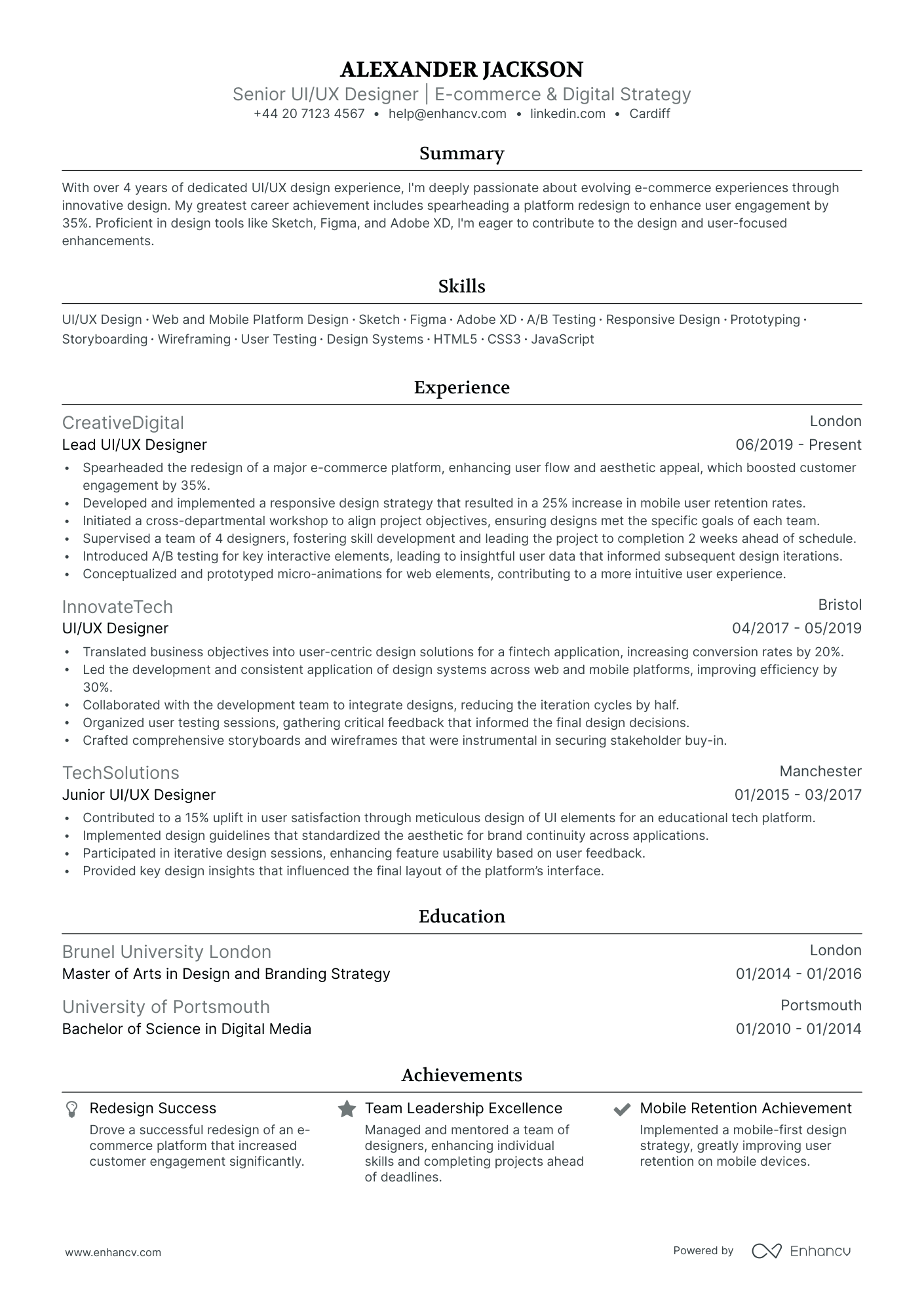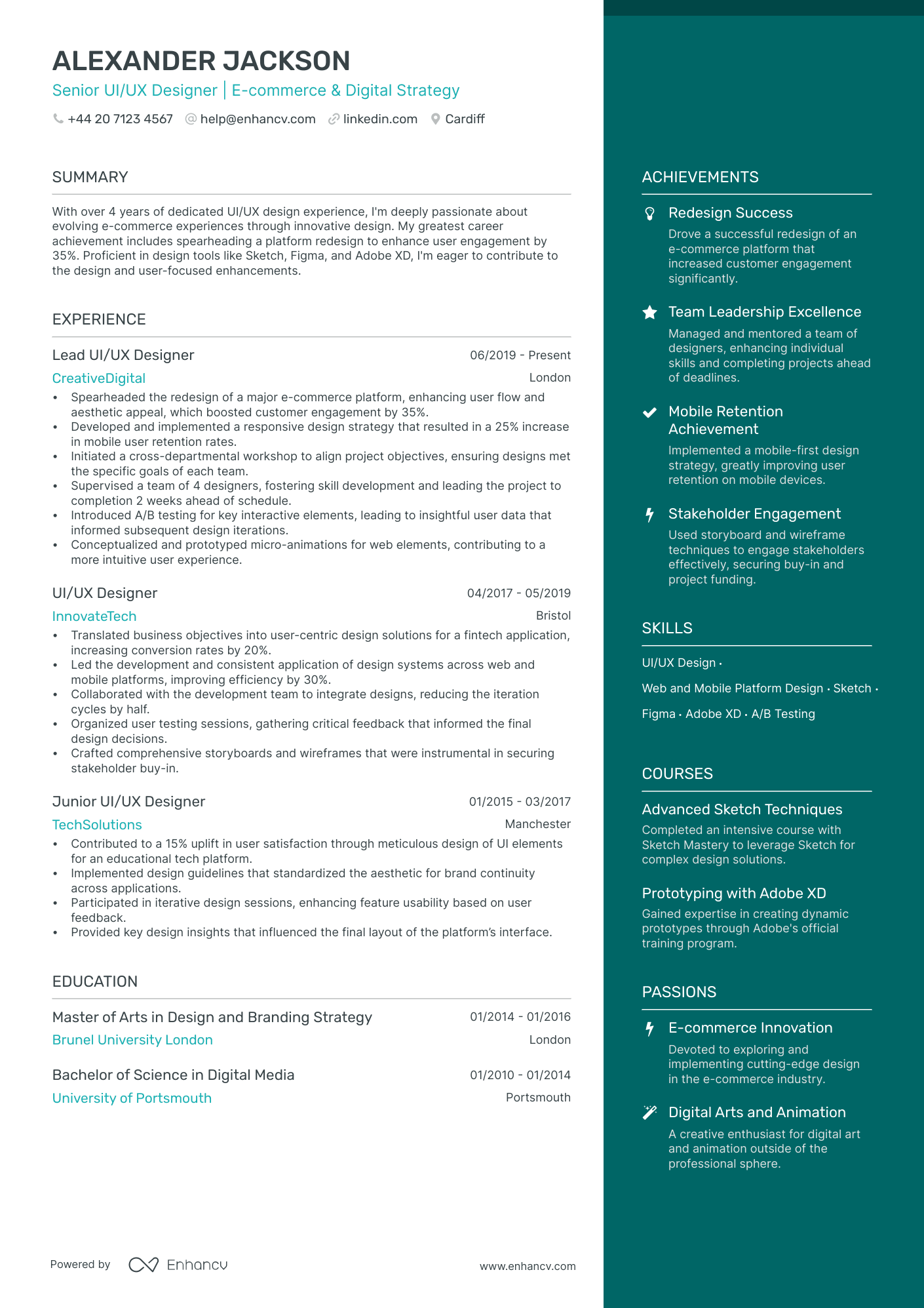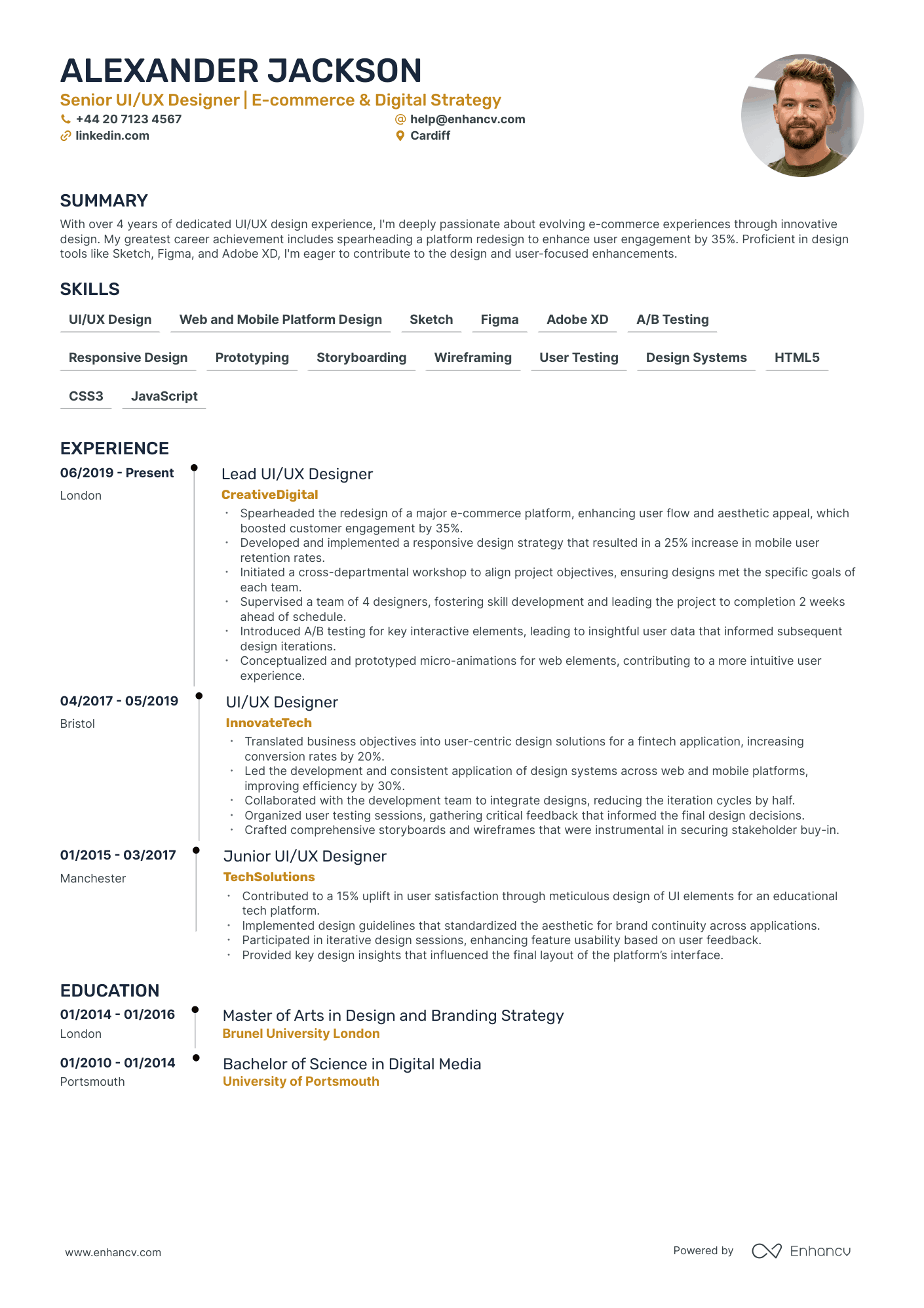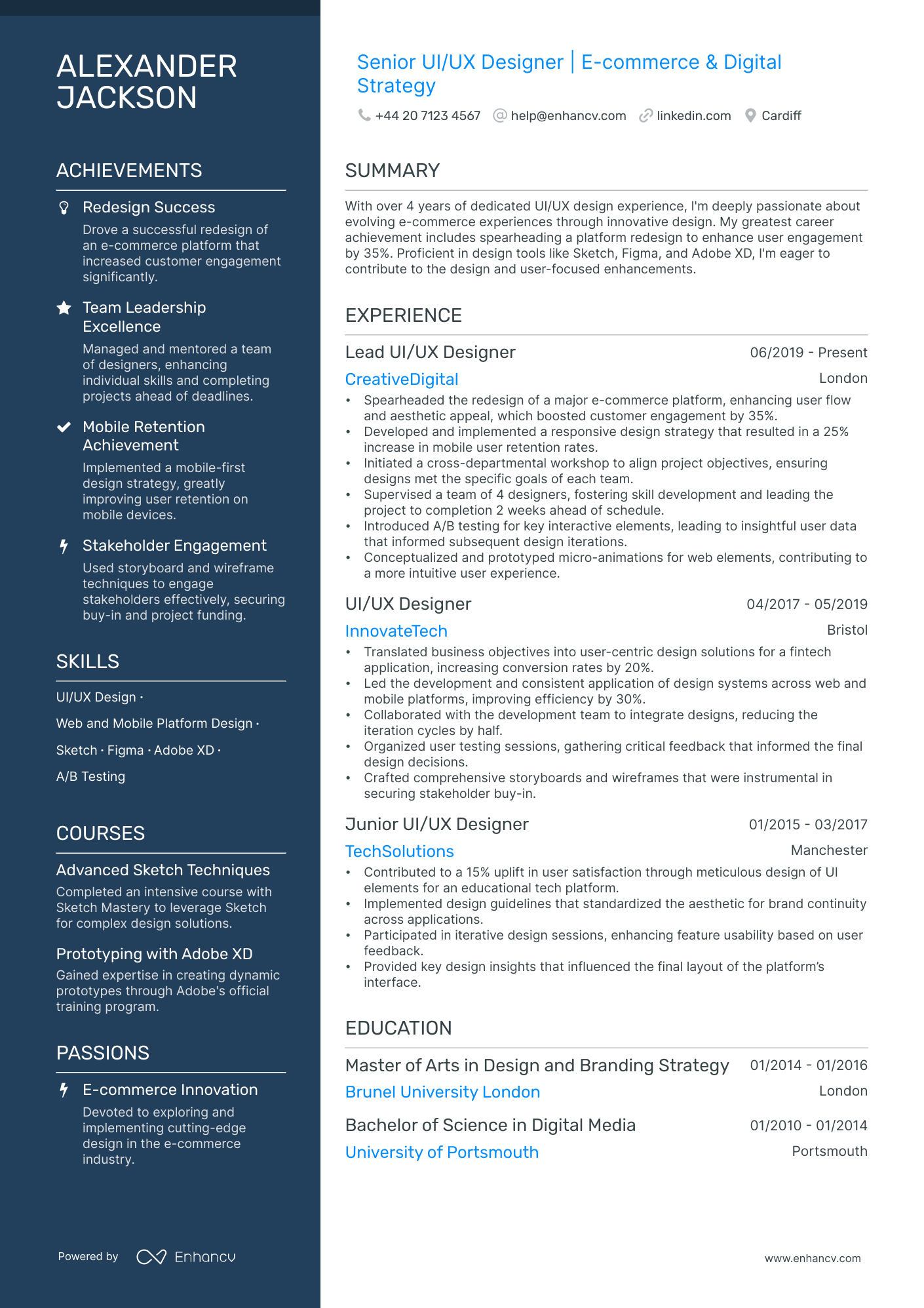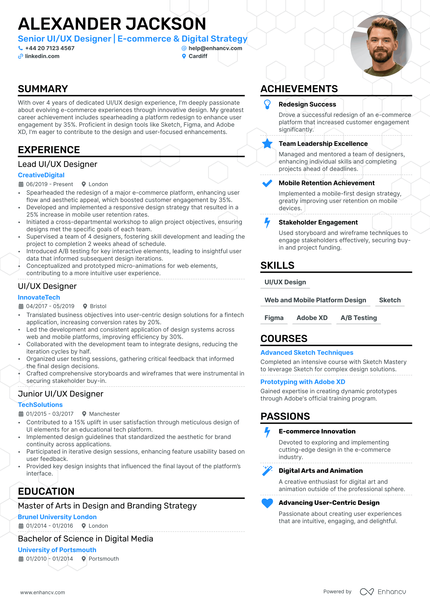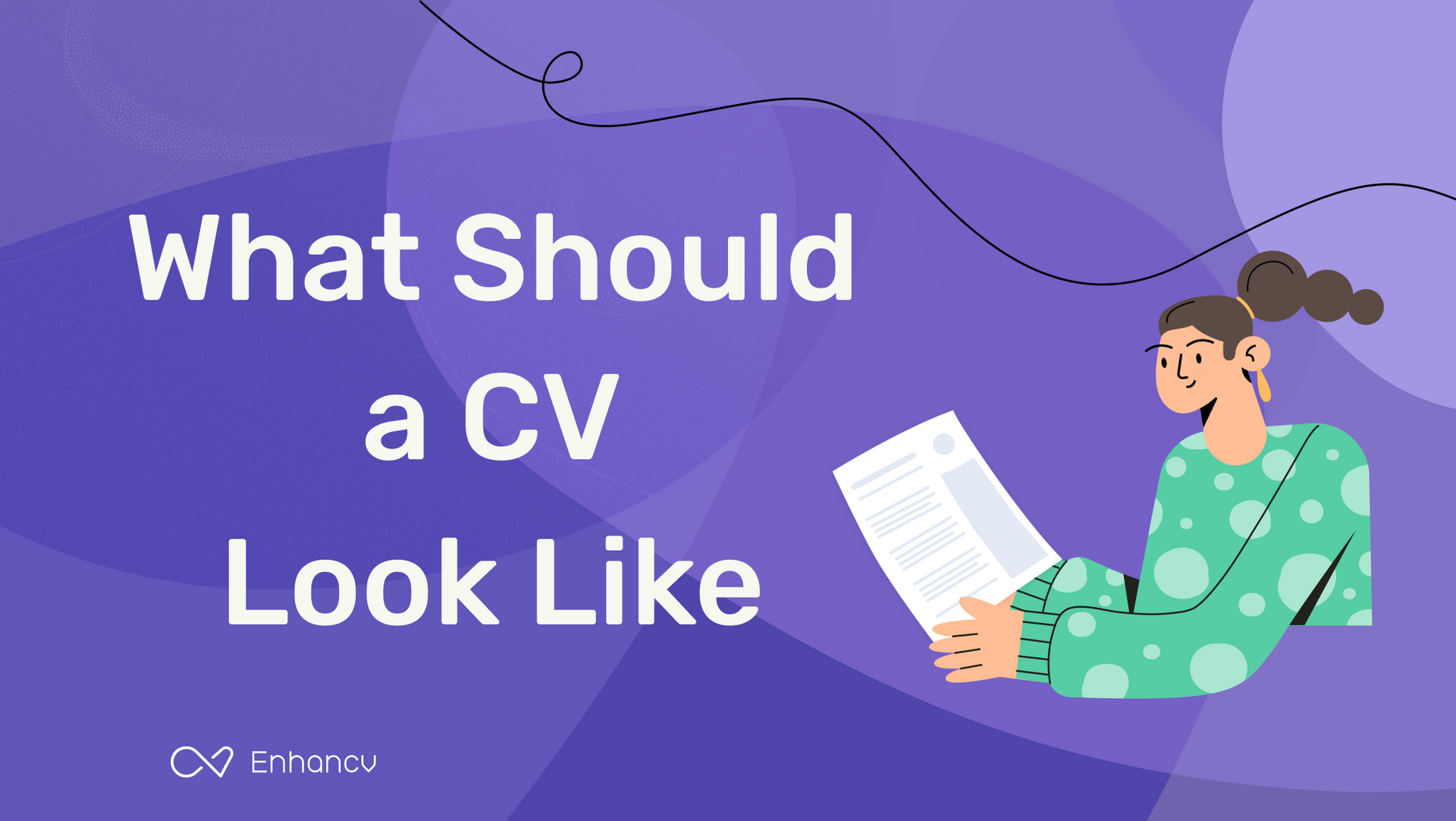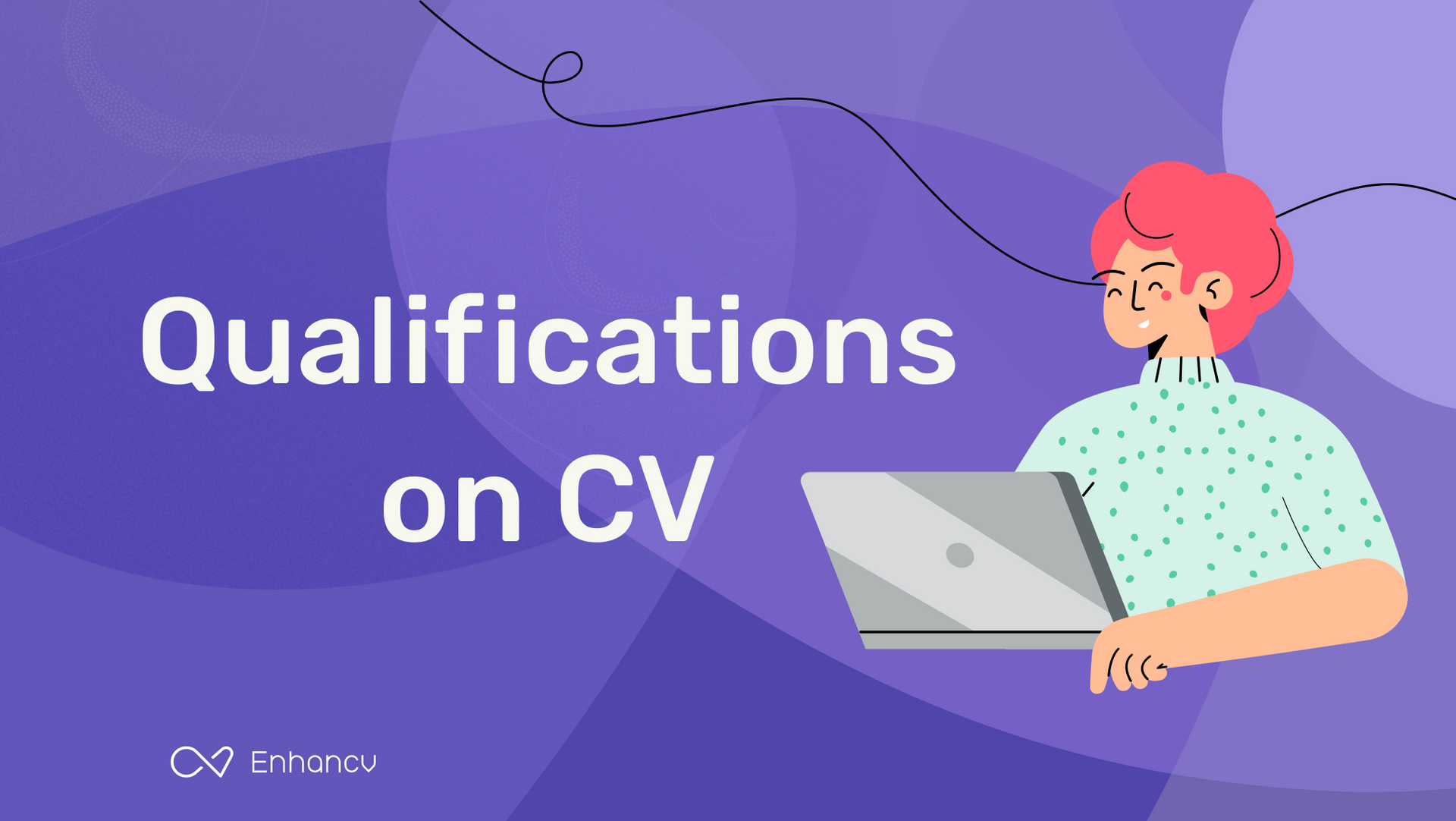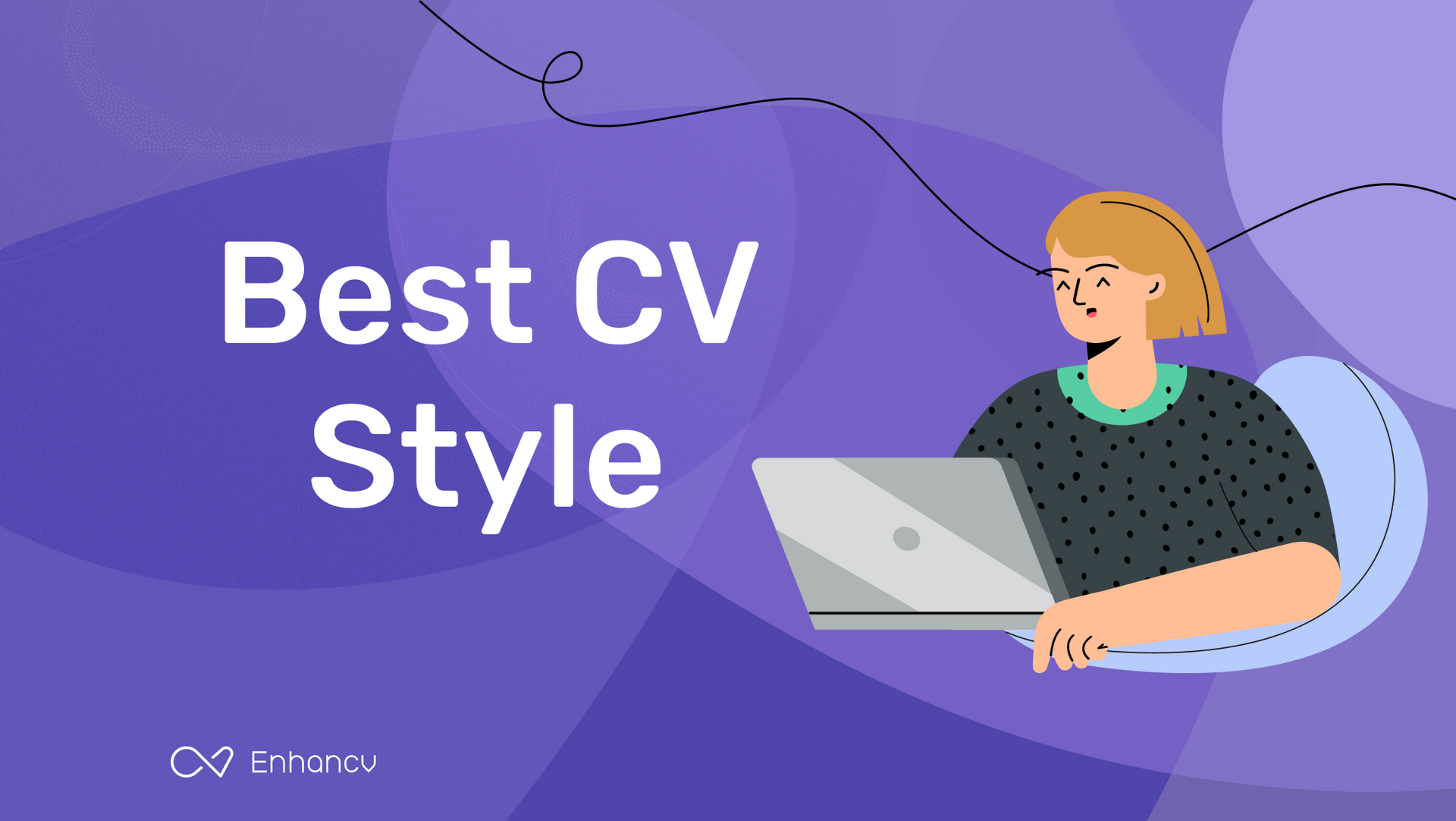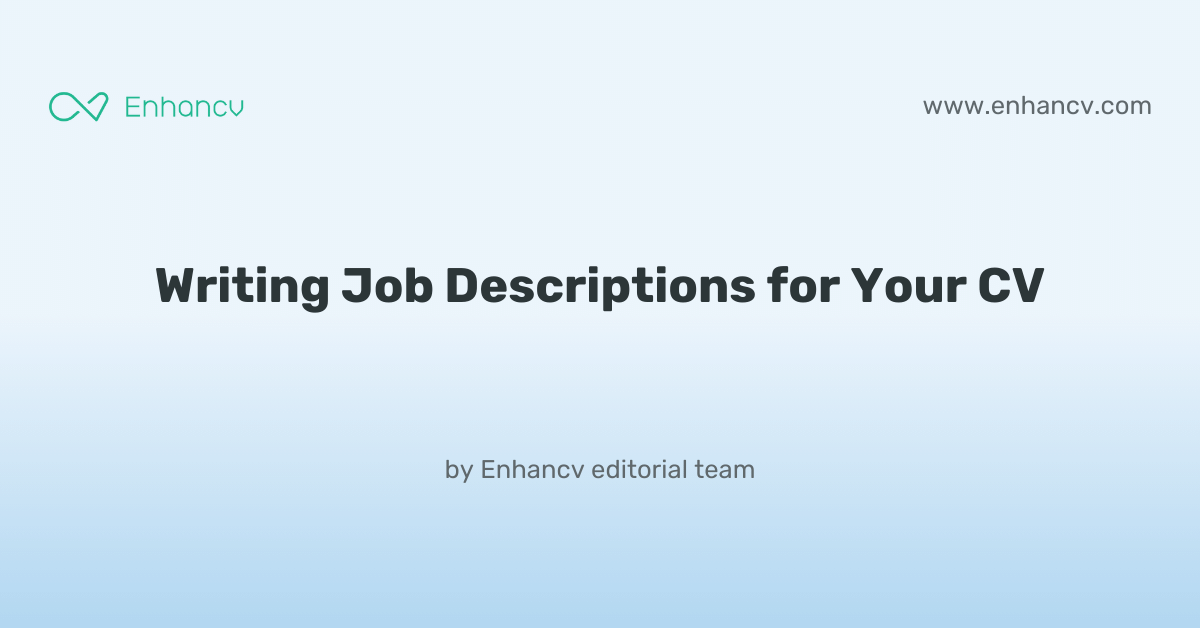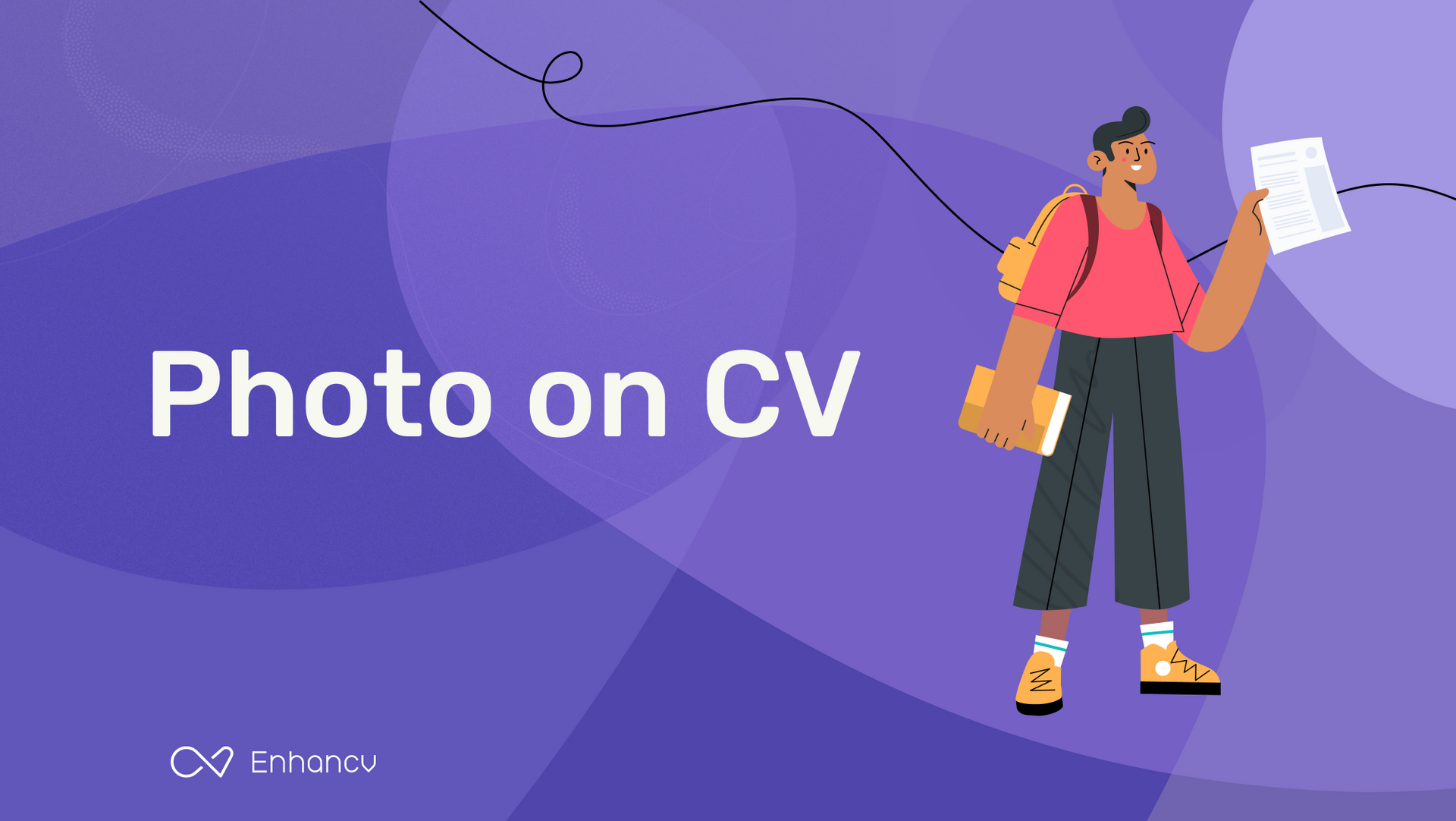Crafting a UX designer CV that effectively showcases your design process and impact can be a daunting task. Our guide provides practical tips to distil your experiences into a compelling narrative, ensuring your unique value proposition shines through.
- Applying best practices from real-world examples to ensure your profile always meets recruiters' expectations;
- What to include in your work experience section, apart from your past roles and responsibilities?
- Why are both hard and soft skills important for your application?
- How do you need to format your CV to pass the Applicant Tracker Software (ATS) assessment?
If you're writing your CV for a niche ux designer role, make sure to get some inspiration from professionals:
Structuring and formatting your ux designer CV for an excellent first impression
The experts' best advice regarding your CV format is to keep it simple and concise. Recruiters assessing your CV are foremost looking out for candidates who match their ideal job profile. Your white space, borders, and margins. You may still be wondering which format you need to export your CV in. We recommend using the PDF one, as, upon being uploaded, it never alters your information or CV design. Before we move on to the actual content of your ux designer CV, we'd like to remind you about the Applicant Tracker System (or the ATS). The ATS is a software that is sometimes used to initially assess your profile. Here's what you need to keep in mind about the ATS:- All serif and sans-serif fonts (e.g. Rubik, Volkhov, Exo 2 etc.) are ATS-friendly;
- Many candidates invest in Arial and Times New Roman, so avoid these fonts if you want your application to stand out;
- Both single and double column CVs can be read by the ATS, so it's entirely up to you to select your CV design.
PRO TIP
Use bold or italics sparingly to draw attention to key points, such as job titles, company names, or significant achievements. Overusing these formatting options can dilute their impact.
The top sections on a ux designer CV
- Professional Experience to highlight relevant UX projects.
- UX Design Portfolio showing a diverse range of work.
- Technical Skills including specific UX design tools.
- Education & Certifications relevant to UX design field.
- User Research Experience illustrating empathy skills.
What recruiters value on your CV:
- Highlight your understanding of usability principles and your ability to empathise with users by providing examples of user research, personas, and user journey maps you've created.
- Showcase your design process by outlining how you go from research to wireframes to prototypes, and finally to high-fidelity designs, ideally with a link to your online portfolio.
- Include metrics when possible to demonstrate the impact of your design decisions on user experience and business goals, such as increased conversion rates or improved user engagement.
- Detail your proficiency in UX design tools like Sketch, Adobe XD, Figma, and InVision, as well as any familiarity with front-end development technologies such as HTML, CSS, and JavaScript.
- Explain your soft skills, such as collaborative work, communication, and project management, which are crucial in a multidisciplinary field such as UX design.
Recommended reads:
Tips and tricks on writing a job-winning ux designer CV header
The CV header is the space which most recruiters would be referring most often to, in the beginning and end of your application. That is as the CV header includes your contact details, but also a headline and a professional photo. When writing your CV header:
- Double-check your contact details for spelling errors or if you've missed any digits. Also, ensure you've provided your personal details, and not your current work email or telephone number;
- Include your location in the form of the city and country you live in. If you want to be more detailed, you can list your full address to show proximity to your potential work place;
- Don't include your CV photo, if you're applying for roles in the UK or US, as this may bias initial recruiters' assessments;
- Write a professional headline that either integrates the job title, some relevant industry keywords, or your most noteworthy achievement.
In the next part of our guide, we'll provide you with professional CVs that showcase some of the best practices when it comes to writing your headline.
Examples of good CV headlines for ux designer:
- Senior UX Designer | Human-Centred Design | Wireframing & Prototyping | 8+ Years Experience | UX Certification
- Lead UX/UI Designer | Interaction Design Specialist | Agile Methodologies | 10+ Years | Master's in Digital Media
- UX Design Manager | User Research | Team Leadership | 12 Years in Tech | Certified UX Professional
- Mid-Level UX Strategist | Information Architecture | Usability Testing | 5 Years Experience | Bachelor's in Graphic Design
- Junior UX Designer | UX/UI Principles | Collaboration & Feedback | 2 Years Practical Experience | Graduate Diploma in UX
- Experienced UX Consultant | User Journey Mapping | Heuristic Evaluation | 7+ Years | Professional Diploma in UX Design
Choosing your opening statement: a ux designer CV summary or objective
At the top one third of your CV, you have the chance to make a more personable impression on recruiters by selecting between:
- Summary - or those three to five sentences that you use to show your greatest achievements. Use the CV summary if you happen to have plenty of relevant experience and wish to highlight your greatest successes;
- Objective - provides you with up to five sentences to state your professional aims and mission in the company you're applying for
CV summaries for a ux designer job:
Narrating the details of your ux designer CV experience section
Perhaps you've heard it time and time again, but, how you present your experience is what matters the most. Your CV experience section - that details your work history alongside your accomplishments - is the space to spotlight your unqiue expertise and talents. So, avoid solely listing your responsibilities, but instead:
- adverts' keywords and integrate those in your experience section;
- Use your CV to detail how you've been promoted in the past by including experience in the reverse chronological order.
Before you start writing your ux designer CV experience section, dive into some industry-leading examples on how to structure your bullets.
Best practices for your CV's work experience section
- Executed comprehensive user research for a fintech mobile app that increased user retention by 30% through improved user flows and interface design.
- Collaborated with cross-functional teams to create intuitive and accessible designs for a healthcare platform, resulting in a 25% uptick in user satisfaction scores.
- Led the redesign of an e-commerce website using a customer-centric approach, which boosted conversion rates by 18% and decreased cart abandonment.
- Employed Agile and Lean UX methodologies to iteratively improve the user experience of a SaaS product, decreasing the time to task completion by 20%.
- Developed and maintained a comprehensive UI design system that ensured brand consistency across all digital products for a multinational corporation.
- Conducted A/B testing on various UI elements that led to data-driven design decisions and a 15% increase in user engagement for a social media platform.
- Utilised strong prototyping skills to create highly interactive mock-ups for user testing sessions that informed the development of a successful educational app.
- Championed accessibility standards in design projects, ensuring compliance with WCAG 2.0 guidelines and improving inclusivity for users with disabilities.
- Presented regular UX insights and strategic recommendations to stakeholders, effectively communicating complex design concepts and their impact on business goals.
- Led the UX redesign of a major e-commerce platform, enhancing user satisfaction by 35% and contributing to a 20% increase in conversion rates.
- Pioneered the integration of voice-assistant technology into the company’s mobile app, helping widen our product's reach to accessibility-focused user groups.
- Conducted extensive A/B testing to refine user workflows, which resulted in an average session duration increase of 50%.
- Established a user-centered design framework, resulting in the development of an award-winning mobile application used by over 1 million users.
- Successfully managed cross-functional teams across 4 projects simultaneously, ensuring timely delivery and exceeding key performance indicators by 25%.
- Instrumental in user experience research that led to an innovative feature set increasing user engagement by 40%.
- Authored and implemented a new user experience strategy for SaaS products that saw customer retention rates increase by 30%.
- Orchestrated the complete revamp of the user interface for the company's flagship product, subsequently enhancing user efficiency by over 25%.
- Facilitated regular user testing workshops, which provided crucial feedback that drove continuous improvement cycles.
- Revolutionized the user interface of the company’s analytics dashboard, directly leading to a 20% uptick in daily active users.
- Developed user personas and scenarios to guide effective feature development, which subsequently cut down onboarding time by 15%.
- Partnered with development teams to iterate on product designs rapidly, enhancing the overall user satisfaction rate by 30%.
- Overhauled user flow and information architecture for a major online retailer, improving navigation ease and reducing bounce rates by 18%.
- Designed and prototyped an interactive onboarding experience for new users, resulting in a 25% improvement in user retention.
- Collaborated with marketing and product management to align the user experience with the brand’s mission, lifting brand recognition by 10%.
- Initiated and led a user-centered design project that culminated in a 40% increase in customer satisfaction ratings for the company’s web services.
- Conducted heuristic evaluations and usability testing to identify and address design pain points, reducing customer service inquiries by 22%.
- Integrated responsive design principles into existing web properties, significantly improving accessibility and user experience on mobile devices.
- Headed the development of a new feature in the company’s social media app that resulted in an additional 10 minutes of average daily use per user.
- Crafted and executed a comprehensive redesign of the user experience for a suite of mobile apps, increasing the review scores from an average of 3.5 to 4.5 stars.
- Implemented a structured user feedback system that has since driven an agile and iterative design process, significantly reducing time to market for new features.
- Empowered a team of junior designers through mentorship, which led to the launch of a critically acclaimed app redesign, increasing user acquisition by 50%.
- Devised usability testing initiatives that enhanced feature adoption by 60% by closely aligning with user expectations and behaviors.
- Fostered a collaborative design sprint culture, significantly reducing the prototype development cycle from 3 weeks to just 1 week.
How to ensure your ux designer CV stands out when you have no experience
This part of our step-by-step guide will help you substitute your experience section by helping you spotlight your skill set. First off, your ability to land your first job will depend on the time you take to assess precisely how you match the job requirements. Whether that's via your relevant education and courses, skill set, or any potential extracurricular activities. Next:
- Systematise your CV so that it spotlights your most relevant experience (whether that's your education or volunteer work) towards the top;
- Focus recruiters' attention to your transferrable skill set and in particular how your personality would be the perfect fit for the role;
- Consider how your current background has helped you build your technological understanding - whether you've created projects in your free time or as part of your uni degree;
- Ensure you've expanded on your teamwork capabilities with any relevant internships, part-time roles, or projects you've participated in the past.
Recommended reads:
PRO TIP
Include examples of how you adapted to new tools, environments, or work cultures, showing your flexibility.
The CV skills' divide: between hard and soft skills
Of course, you may have read the job requirements plenty of times now, but it's key to note that there is a difference between technical and personal skills. Both are equally relevant to your job application. When writing about your skill set, ensure you've copy-pasted the precise skill from the job requirement. This would not only help you ensure you have the correct spelling, but also pass any Applicant Tracker System (ATS) assessments.
- Hard skills show your technological capabilities. Or whether you'll be a good technical fit to the organisation. Ensure you've spotlighted your hard skills in various sections of your CV (e.g. skills section, projects, experience) by including the technology and what you've attained;
- Soft skills pinpoint your personality and people or communication skills, hinting at if you'll easily accomodate into the team or organisation. Quantify your soft skills in your CV achievements, strengths, summary/objective, and experience sections. Always support your soft skills with how they've helped you grow as a professional.
Top skills for your ux designer CV:
User Research
User Interface Design
User Experience Design
Prototyping
Information Architecture
Wireframing
Usability Testing
Interaction Design
Visual Design
Responsive Design
Creativity
Problem-solving
Communication
Empathy
Collaboration
Adaptability
Critical Thinking
Attention to Detail
Time Management
User-Centric Mindset
PRO TIP
Focus on describing skills in the context of the outcomes they’ve helped you achieve, linking them directly to tangible results or successes in your career.
Your university degree and certificates: an integral part of your ux designer CV
Let's take you back to your uni days and decide what information will be relevant for your ux designer CV. Once more, when discussing your higher education, select only information that is pertinent to the job (e.g. degrees and projects in the same industry, etc.). Ultimately, you should:
- List only your higher education degrees, alongside start and graduation dates, and the university name;
- Include that you obtained a first degree for diplomas that are relevant to the role, and you believe will impress recruiters;
- Showcase relevant coursework, projects, or publications, if you happen to have less experience or will need to fill in gaps in your professional history.
PRO TIP
Use mini case studies or success stories in your CV to demonstrate how your skills have positively impacted previous roles or projects.
Recommended reads:
Key takeaways
Write your professional ux designer CV by studying and understanding what the role expectations are. You should next:
- Focus on tailoring your content to answer specific requirements by integrating advert keywords through various CV sections;
- Balance your technical know-how with your personal skills to showcase what the unique value would be of working with you;
- Ensure your CV grammar and spelling (especially of your key information and contact details) is correct;
- Write a CV summary, if your experience is relevant, and an objective, if your career ambitions are more impressive;
- Use active language by including strong, action verbs across your experience, summary/objective, achievements sections.
